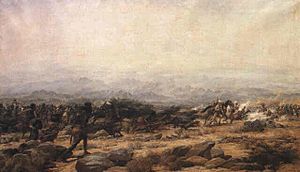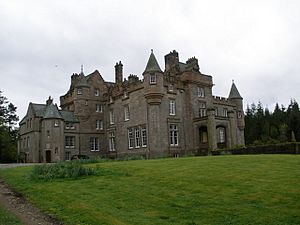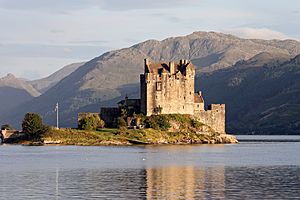John MacRae-Gilstrap facts for kids
John MacRae-Gilstrap (born December 31, 1861 – died January 1937) was a British army officer. He was also an important member of the Clan Macrae, a famous Scottish family. John MacRae-Gilstrap bought and rebuilt Eilean Donan Castle in 1912. This old castle, located on Loch Duich in western Scotland, was a special place for the Macrae clan. He also had a big role in a discussion about who should be the main leader of the clan.
Contents
His Family and Early Life
John MacRae was the second son of Duncan MacRae and Grace Stewart. He was born in Punjab, a region in India. His father was a surgeon who worked with the East India Company during a major conflict in India in 1857.
Later, his family moved back to Scotland. They lived at Kames Castle on the Isle of Bute. John's older brother, Stuart, was also born in India. Stuart later became a famous football player for the England team in the 1880s. John's grandfather, Major Colin MacRae, was also a soldier in India. Even further back, his great-great-grandfather, John MacRae of Conchra, was one of four men known as the "Four Johns of Scotland." They fought for the Jacobites in the Battle of Sheriffmuir in 1715 and sadly lost their lives.
His Time as a Soldier
In 1883, John MacRae joined the 1st battalion of The Royal Highland Regiment (The Black Watch) as a lieutenant. The next year, he went to Egypt. His regiment was fighting in the Mahdist War there. He took part in the battle of Tamai on March 13, 1884.
In September, he was put in charge of a group of boats for the Nile Expedition. This mission tried to help soldiers stuck in the Siege of Khartoum, but it wasn't successful. During the expedition, his group was attacked at Kirbekan in February 1885. The Mahdists were defeated in this battle. John MacRae was praised for his actions and received the Egypt Medal and a bronze Khedive's Star.
After this, the British army left Sudan. John MacRae and his regiment went to Malta. They returned to Perth in 1889. The next year, he was promoted to captain. In 1901, he joined the Royal Company of Archers, which is a special ceremonial bodyguard for the King or Queen in Scotland.
Marriage and New Name
On March 4, 1889, John MacRae married Isabella Mary Gilstrap. She was the second daughter of George Gilstrap from Newark. Isabella was also the niece of Sir William Gilstrap, a very rich man who made malt (used to make beer) and gave a lot to charity.
When Sir William died in 1896, John MacRae added "Gilstrap" to his name, as Sir William's will requested. He also took on an important role in the Gilstrap family business, which was the biggest malt-making company in Britain at the time. In 1897, the MacRae-Gilstraps lived in Newark. In 1899, they bought Ballimore House in Otter Ferry, Argyll, Scotland.
The Clan Macrae Leadership Debate
John MacRae-Gilstrap was a key member of the MacRae family from Conchra. This family branch came from Alexander MacRae, who gained land near Eilean Donan Castle in 1677. The MacRaes of Conchra are one of several main branches of the clan. Each of these families believed they were the most important.
Even though a book published in 1899 said the Inverinate branch was the most senior, people still argued about it. No MacRae had ever been officially recognized as the "chief" or main leader of the clan. The MacRaes were very close allies with the Clan Mackenzie. They even served as bodyguards for the Mackenzie chief, earning the nickname "Mackenzie's Shirt of Mail."
In 1909, Sir Colin MacRae of Inverinate asked the Lord Lyon, Scotland's official in charge of coats of arms, to recognize him as the Chief of the Clan MacRae. John MacRae-Gilstrap had already asked the Lord Lyon to tell him if anyone tried to claim this title. He wanted to have a chance to speak up.
The Lord Lyon's court heard the case. John MacRae-Gilstrap was asked if he had the right to be there. He replied, "I am here to protect myself and to say that I will not acknowledge the Inverinate branch in any shape or form as the Chief of the Clan MacRae and as my Chief." He believed that "all the MacRae families are more or less on an equality." He also argued that the MacRaes were a clan that had no chief other than the Mackenzie chief, Seaforth.
In April 1909, the Lord Lyon, James Balfour Paul, made a decision. He focused only on the coats of arms. He found that Sir Colin had not proven his right to use the chief's coat of arms. So, the question of who was the actual clan chief was not officially decided. The debate about recognizing a clan chief continued, with Sir Colin still calling himself chief and MacRae-Gilstrap still disagreeing.
Rebuilding Eilean Donan Castle
Eilean Donan Castle was likely first built in the 1200s. It was a strong castle for the Mackenzies of Kintail. For many years, they appointed members of the Clan MacRae to look after it. The last MacRae in charge was Rev. Farquhar MacRae, who was removed in 1651. He was an ancestor of John MacRae-Gilstrap.
During a failed Scottish uprising in 1719, Spanish soldiers took over the castle. After the Spanish surrendered, government forces destroyed the castle. By 1912, the castle, located on an island in Loch Duich on Scotland's west coast, was just a few broken stone walls.
In 1912, MacRae-Gilstrap bought Eilean Donan Castle. He bought it from Sir Keith Fraser of Inverinate. This made him the first MacRae in many years to own land in Kintail, the traditional MacRae area. At first, MacRae-Gilstrap only wanted to keep the ruins as they were. He hired a local stonemason, Farquhar MacRae, to clear the site.
John MacRae-Gilstrap was busy during the First World War. When he returned to Kintail in 1919, he found Farquhar MacRae getting ready to fully rebuild the castle. Farquhar said he had a dream where he saw exactly how the castle looked originally. MacRae-Gilstrap agreed to rebuild it. He hired architect George Mackie Watson to draw up the plans. The castle was completely rebuilt between 1920 and 1932. In 1932, the bridge connecting the castle to the mainland was finished. A special opening ceremony was held on July 22, 1932. The total cost to rebuild the castle was about £250,000, mostly paid for by the money John MacRae-Gilstrap inherited from the Gilstrap family.
His Later Life and Legacy
John MacRae-Gilstrap passed away in January 1937 at Eilean Donan Castle. He was buried at the old MacRae cemetery in Clachan Duich, at the top of Loch Duich. His wife, Isabella, lived until 1949. John and Isabella had five daughters and one son.
His properties, including the castle, went to his son, Captain Duncan MacRae (1890–1966). Then they passed to Duncan's son, John MacRae (1925–1988). This John MacRae opened Eilean Donan Castle to the public in 1955. In 1983, he created the Conchra Charitable Trust to help take care of the castle. Today, his great-granddaughter, Baroness Miranda van Lynden, is the current head of the MacRaes of Conchra.




